All about Tswana culture: people, history, traditions, food, and clothing
If you have been to Botswana, you have heard of the Tswana culture. It is one of the most dominant tribes in this nation and is well known for its unique characteristics. The unique feature of this culture is the cuisine.

Source: UGC
Batswana culture is a significant aspect of Botswana's history. Tswana culture pictures vividly capture the diverse traditions, rituals, and attire that define the rich cultural heritage of the Tswana people in Southern Africa.
All about Tswana culture: food, clothing, and traditions
The Tswana people are a Bantu ethnic group. Here is a brief overview of Tswana culture and what their tradition entails.
Who makes up the Tswana culture?
There are four important ethnic groups in the Black population of South Africa: the Nguni, the Sotho-Tswana, Shangaan-Tsonga, and the Venda. The Sotho and the Nguni make up the more significant percentage of the Black population.
The primary Sotho groups include the South Sotho (Basduto and Sotho), the West Sotho (Tswana), and the North Sotho (Pedi). The Tswana people are a Bantu-speaking ethnic group that resides in the southern part of Africa.
They are mostly found in Botswana. The ethnic group is the native people of Botswana and spread to the North West province of South Africa, where most of the Tswana live. They are popular in the country due to their Tswana dance, their unique Setswana names, and the gorgeous Tswana wedding dresses.
History of the Tswana people
Given the large percentage of the Tswana culture, most individuals often want to know the Tswana tradition and various aspects of their roots, such as the Tswana traditional dance, the Tswana traditional food, and the Tswana traditional attire.
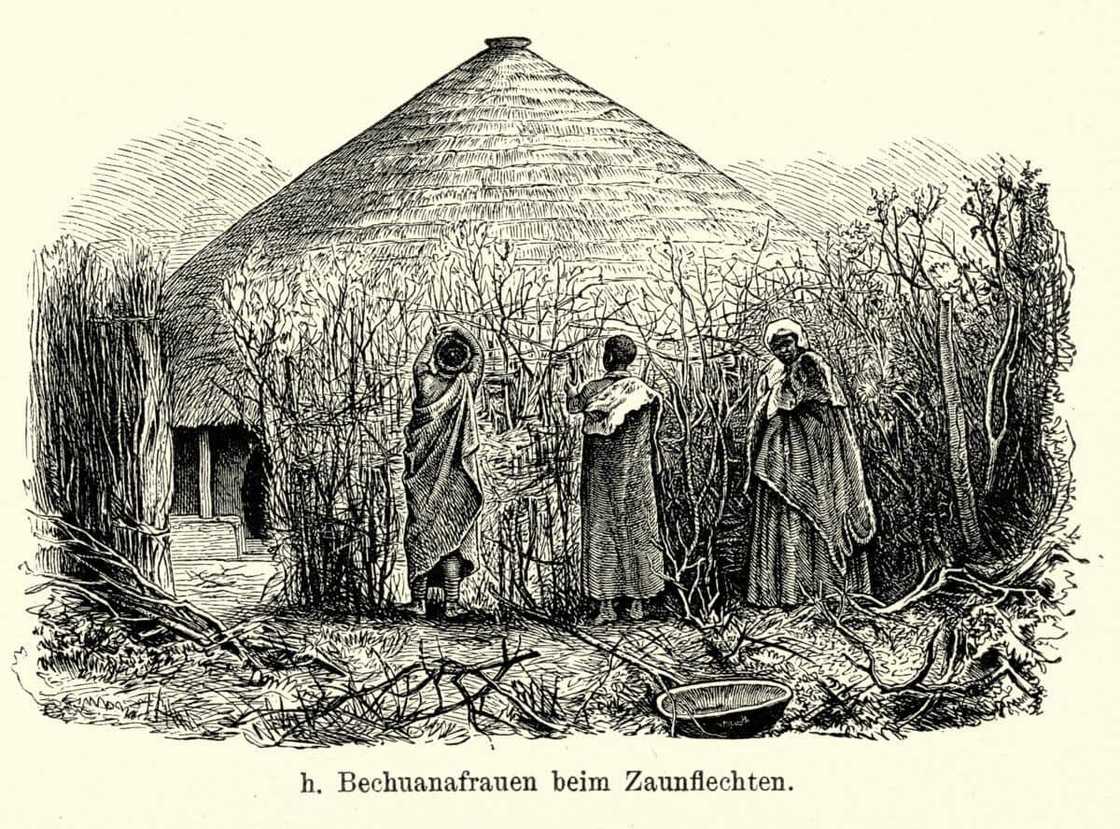
Source: Getty Images
The history of this pre-dominant tribe goes back to the eighteenth century. Most people who lived more than two thousand years ago are believed to have been Bushmen. They were often herders and agriculturalists.
Around the seventeenth and eighteenth centuries, the polities of this tribe, under the reign of the chiefs, moved into Botswana from the south and the east. Some of them were responding to the emergence of the Zulu state and the European colonisers.
In 1816, the missionisation of this ethnic tribe began. It led to the Tswana polities embracing the migrant labour economy, centring on South Africa, trade, and Christianity. In 1885, the British declared the area the Bechuanaland Protectorate, making three Tswana kings visit Britain in 1895.
During the visit, the kings petitioned to remain under the rule of the British rather than be governed by the British South Africa Company. The administration of the British strengthened the role of the Tswana chiefs, leading to the dominance of the Tswana laws and customs throughout the country.
Religious beliefs of the Tswana people
During the pre-colonial era, most of the Batswana believed in a supreme being by the name Modimo. Modimo was thought to be a creator and director who was distant and remote. Despite believing in a supreme being, this ethnic group also believed in the ancestors, also known as the Badimo.
The Badimo had a significant influence on the daily activities of the members of the tribe, and therefore, appeals to them were made with sacrifices, prayers, and appropriate behaviour.
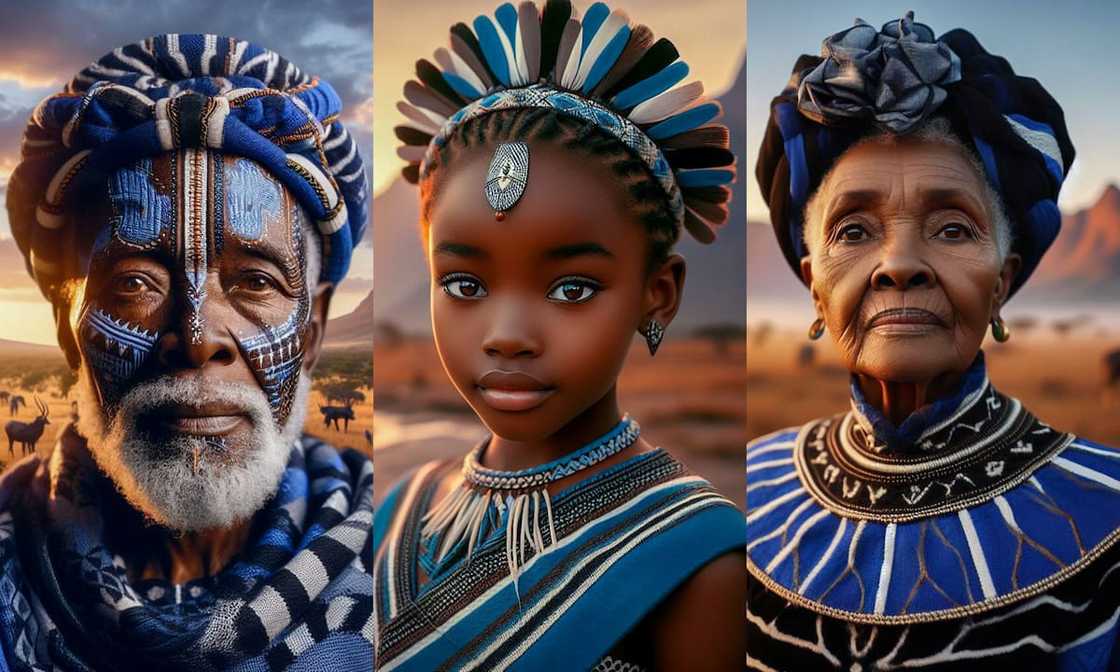
Source: UGC
However, in the early nineteenth century, the missionaries arrived in the region with the Batswana. They brought about education, Christianity, schools, and Western values in the tribe.
Today, most Batswana belong to the African Independent Churches, which embrace the Christian and non-Christian beliefs, myths, and practices.
Tswana culture food, and clothes
The Tswana have attractive African traditional attire, commonly known as the Tswana traditional wear. Men traditionally wear a garment known as Tshega, consisting of a blanket made from animal skin, called Kaross, draped over the loin region.
This attire is complemented by a cap made from animal skin paired with sandals and belts. In addition to the basic ensemble, men adorn themselves with ornamental items like beads, necklaces, and armlets, enhancing the overall aesthetic of their traditional attire.
Botswana women traditionally wear a garment called Khiba, consisting of a skirt paired with a Mosese, a blanket made from animal skin (Kaross). The Mosese is draped to cover the upper part of the body, adding a distinctive element to the traditional attire.
This ethnic community also captures the attention of others with their food. One of the most popular types of food in this culture is Bogobe. This is a type of porridge which is made from sorghum or millet.
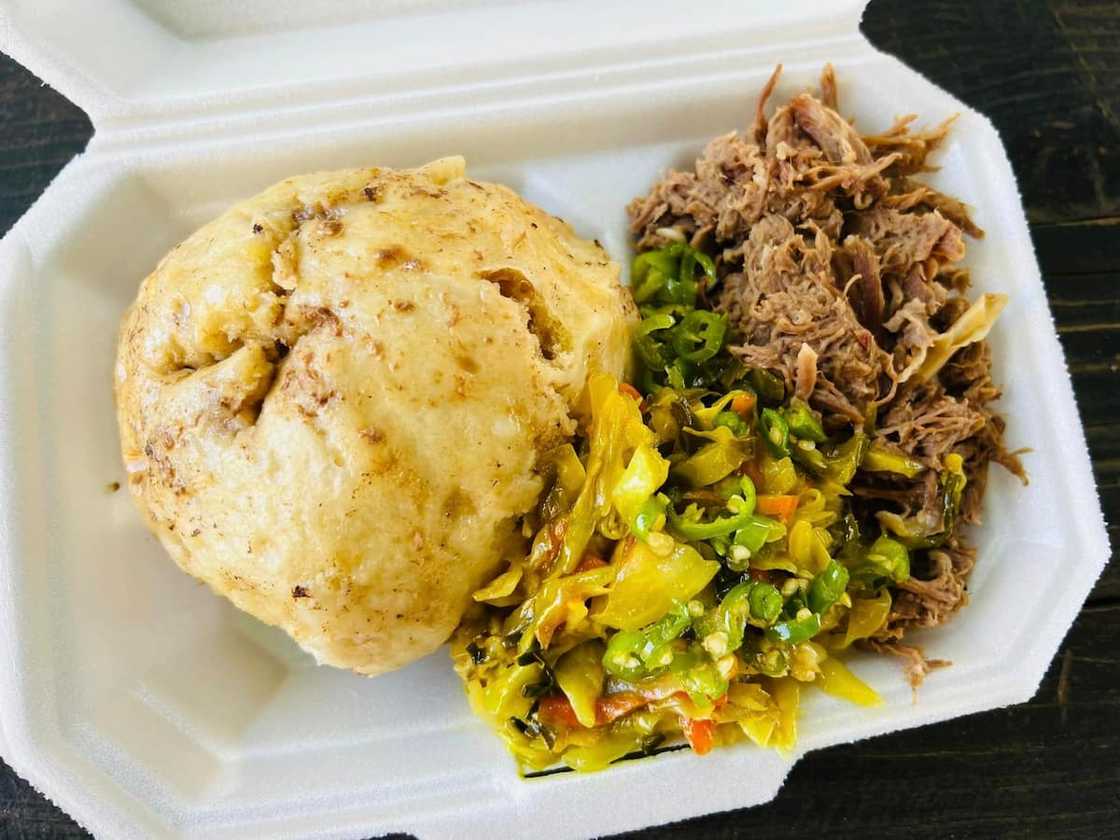
Source: Facebook
Another favourite food that is sorghum porridge is Ting. Bogobe jwa Logala/Sengana is another famous dish which is a traditional Tswana dish that is prepared from sorghum porridge and then mixed or cooked with milk.
One food that is very familiar to many is the Seswaa. It is the national dish in Botswana. It is frequently served at weddings, funerals, and other celebrations. Seswaa is a pounded or shredded meat often served alongside Bogobe.
Another trademark food of this tribe is Madila. It refers to sour cultured milk prepared from goat and cow milk for a specified period until it matures for consumption. It is traditionally prepared using a Lekuka, a leather sack or bag.
Ceremonies
There are very many ceremonies held by this tribe to celebrate or mark certain lifecycle events. Some of these events include birth, marriages, bride-wealth payment, circumcision, confinement, and even death.
Other ceremonies were tied to the agricultural cycle, such as making rain, initiating planting, and the rituals for the first fruits. However, these agrarian ceremonies are no longer practised regularly like before.
Perhaps the most iconic part of the ceremonies is the Tswana cultural clothing. Since the Southern part of Africa is well known for its South African traditional dresses, this ethnic group does not disappoint with its Tswana traditional dress.
There are various dresses for different occasions. Most people long for the Tswana traditional wedding ceremony since it gives one the chance to glance at the Tswana traditional wedding dresses. Precisely, these are among the best South African traditional clothes.
Tswana culture symbols
Tswana culture is rich and diverse, encompassing various symbols that hold cultural, social, and spiritual significance. Some of these symbols include:
- Hornbill (Dikgaba): This is a prominent Tswana cultural symbol associated with rainmaking. It is believed that the presence of a hornbill is a sign that rain is coming, making it a symbol of fertility and prosperity.
- Sorghum plant (Segaiso): Sorghum is a staple crop in Tswana agriculture. The plant represents sustenance, fertility, and the agricultural practices that have sustained Tswana communities for generations.
- Shield (Lephala): The shield is a traditional symbol of defence and protection. In Tswana culture, shields were historically used in warfare for protection, and they also carry symbolic significance in rituals and ceremonies.
- Kraal (Kgatla): The kraal, a traditional African livestock enclosure, symbolises community and family. It represents unity and the importance of communal living among the Tswana people.
- Sickle (Setumu): The sickle symbolises agriculture and represents the importance of farming and cultivation in Tswana society. It symbolises hard work, sustenance, and prosperity derived from the land.
Language of the Tswana ethnic group
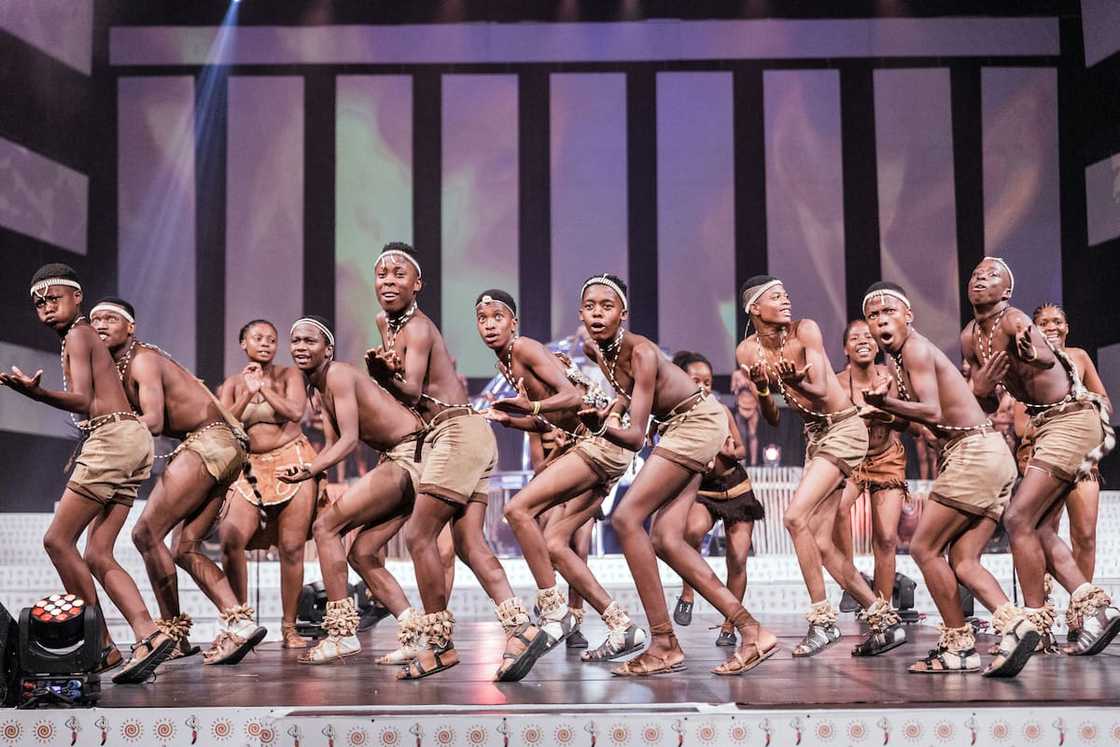
Source: Getty Images
The Tswana or the Batswana are sometimes referred to as the Western Sotho. The Tswana language is Setswana, which is closely related to the Sesotho.
What are Tswana beliefs?
Tswana beliefs are rooted in a rich cultural and spiritual tradition encompassing a deep connection with nature, ancestors, and a supreme being. They have a strong belief in a single, all-powerful God known as Modimo.
What do Tswana wear?
Traditional attire for men includes the Tshega, a blanket made from animal skin (Kaross). Women don the Khiba, a skirt paired with a Mosese, a Kaross blanket that covers the upper body.
What rituals do Tswana practice?
The Tswana people engage in various rituals deeply woven into their cultural and spiritual practices. This includes ceremonies such as offerings to honour and seek guidance from ancestors, communal rituals, agricultural ceremonies, and rites associated with major life events, such as birth, marriage, and death.
What are some traditional Tswana dishes?
Tswana cuisine features pap, samp, vetkoek, bogobe, and mophane worms. A distinctive Botswana dish is seswaa, which consists of salted mashed-up meat.
Is Tswana and Zulu the same?
Tswana and Zulu belong to distinct language families, with Tswana being a member of the Bantu language family, while Zulu is classified within the Nguni subgroup of Bantu languages.
Which country speaks Tswana?
Setswana or Tswana is an African language spoken in South Africa, Botswana, and certain regions of Namibia. It serves as the national language of Botswana and is one of the official languages in South Africa.
The Tswana culture is an admirable culture in southern Africa. Due to this popularity, most people visiting Africa often visit the beautiful country of Botswana to enjoy the culture of the Batswana.
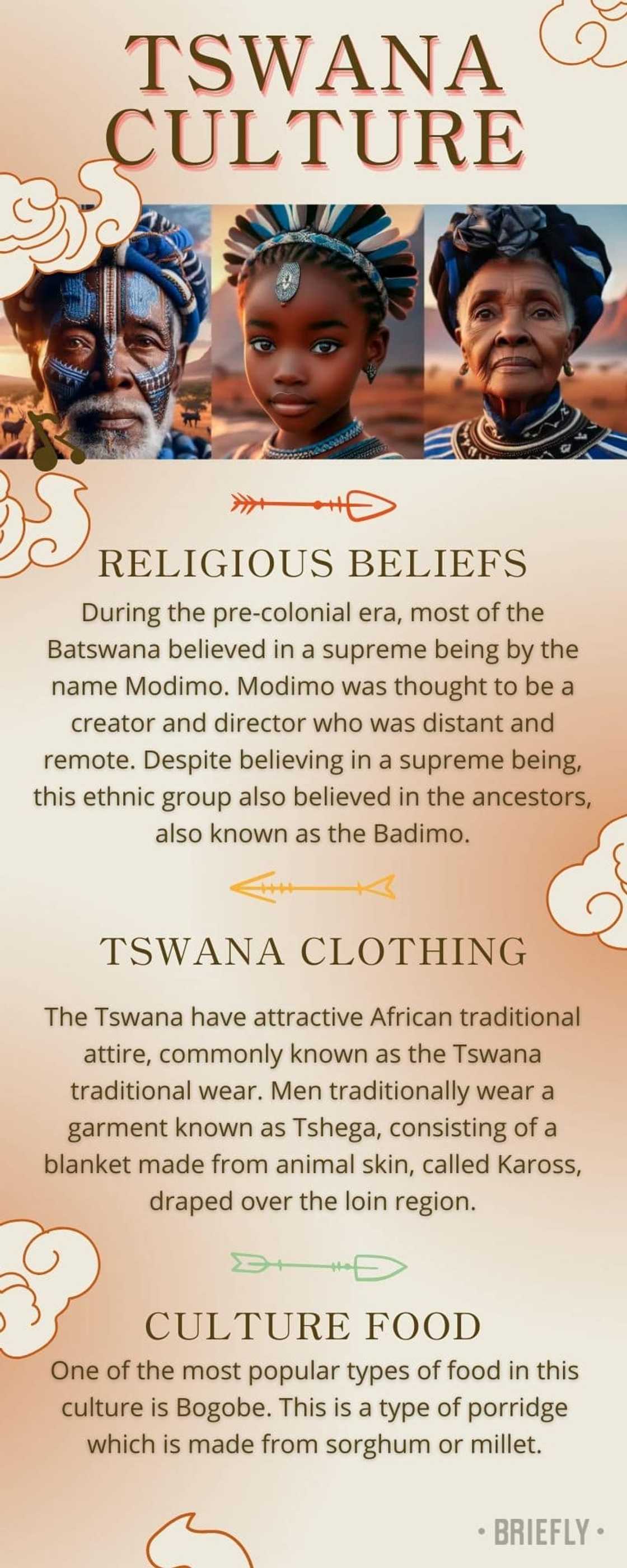
Source: Original
Briefly.co.za recently published an article about the Zulu culture. The Zulu community is known for its rich traditions and culture. Zulu culture, food, and clothing are pretty distinct.
People from this community, especially those in rural areas, are known for their craft-making, weaving, beadwork, and pottery.
Source: Briefly News

Peter Kinuthia Peter Kinuthia is a 2018 graduate of Kenyatta University with a Bachelor's degree in Health Services Management. With over five years of copy-writing experience about media, lifestyle, and health affairs, Peter has cemented a solid career in copy-writing/journalism. He previously worked with Ace My Homework before joining the Briefly team in 2017. With over 5 years of experience in Briefly, Peter has become a remarkable wordsmith. (Email: petekinuthia9@gmail.com)

Jackline Wangare (Lifestyle writer) Jackline Simwa is a content writer at Briefly.co.za, where she has worked since mid-2021. She tackles diverse topics, including finance, entertainment, sports, and lifestyle. Previously, she worked at The Campanile by Kenyatta University. She has more than five years in writing. Jackline graduated with a Bachelor’s degree in Economics (2019) and a Diploma in Marketing (2015) from Kenyatta University. In 2023, Jackline finished the AFP course on Digital Investigation Techniques and Google News Initiative course in 2024. Email: simwajackie2022@gmail.com.






